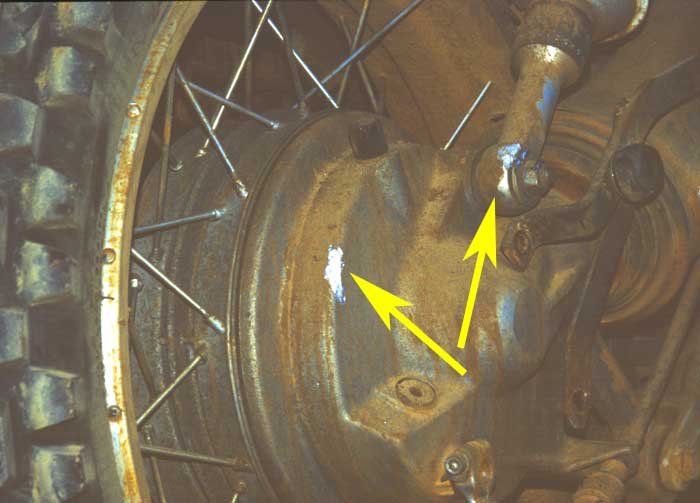 |

17 Jan 2008
|
|
Registered Users
Veteran HUBBer
|
|
Join Date: Sep 2003
Location: Estonia
Posts: 787
|
|
Quote:
Originally Posted by oldbmw

This is not a fixed thing Margus. On the diesel bike forum where bikes often run with a max of 9hp, transmission loss can be substantial. For instance the old Enfield gearbox when filled with grease as recommended consumes over 25% of the crankshaft power. Switching to 90 grade oil halves this, with a further decrease of power absorbtion when using 50 grade oil. The new (since 1995 or so) 5 speed gearbox on 50 grade oil will often allow a bike to go an extra 10mph, as it absorbs very little power.
Many modern bikes run the gears in the very thin synthetic engine oils which reduce drag to a minimum, wheras the bmw's use separate gear oil of 75/80 weight. Worse for BMW's is that the gearbox is directly coupled to the engine, so there is no primary reduction. This means the input shaft turns 2-3 times faster. to compound this problem, the output shaft is offset to drive the shaft. This forced BMW to use a gearbox that not only spins fast but final drive is via transverse cogs, all of which conspire to drain power. Old Gearboxes and most car gearboxes usually lock the input to the output on the same shaft, so in top gear power is not trasferred by energy wasting gears at all. This normally can easily be checked by looking to see if top gear is shown as a 1:1 ratio. Final drive ratio should always use the least amount of intermediaries for highest efficiency ( and probably component life).
|
Hmmm...
I did dynoed my GS and guys who've dynoed most of the bikes and have extensive experiences on this field said the BMW-spec gearbox/paralever drive-train is within the power loss spec of most of other modern shaft-drived systems (or my over 60Kkms done GS performed well above factory performance specs to "cheat" the dyno machine results calculation), including japanese bikes with wet clutches and gearboxes floating in the crankcases in a very thin engine oil. I use spec oils only: usually 75W-90 GL5 both in gear- and bevel box.
The pro for BMW engine+gearbox system is all the shafts rotate parallel, which, at least in theory, should give the best mechanical efficiency and longevity - i.e. lot of unusually high mileage BMWs, Honda STs & Goldwings, some Guzzis. Engines where 90-degree turns are done have their own "uneffective" losses. So maybe that's why on dyno the BMW specs the same as other shaft-drived bikes that have all the friction going on in the thin engine oil, but with 90 degree turn at one point before it's transferred into shaft(?) I.e. bikes like Yamaha Diversion, Suzuki GS or VX, Honda XLV etc.
I agree the power loss ratio does vary, that's why I use the word "approximately" anyways. Depends on the temperatures of oils, mechanical details (i.e. Klingelnberg-Polloid spiral pattern in BMW paralevers), ratios, oil viscosity etc. But with modern shaft drived bikes the power loss is around 18% range running in common transmission oils in bevel boxes. I'm sure Enfields etc with different oils (even full of grease variant as you said) have different results and probably have more power loss than the modern siblings.
Last edited by Margus; 17 Jan 2008 at 08:18.
|

17 Jan 2008
|
 |
Registered Users
Veteran HUBBer
|
|
Join Date: Apr 2001
Location: Norway
Posts: 1,379
|
|
If you feel that the BMW is lazy because of all the powerloss in the driveline (which I personally don’t think is bad compared to an old beaten up chain) there are plenty of modifications that can be done to increase the power. 
Somewhere in the North western corner of Tanzania my pannier more or less fell of when I landed after an unplanned jump. Wonder if chain and sprocket would have made it?

BTW. I also have a bike with chain :-)
|

17 Jan 2008
|
|
Registered Users
Veteran HUBBer
|
|
Join Date: Aug 2007
Location: Sax, Spain
Posts: 901
|
|
|
errr Yes!
Quote:
Originally Posted by AliBaba

Somewhere in the North western corner of Tanzania my pannier more or less fell of when I landed after an unplanned jump. Wonder if chain and sprocket would have made it?
|
Wonder why they don't use SHAFT drive on Moto-cross bikes???
They jump a fair way!
Martyn
|

17 Jan 2008
|
 |
Registered Users
Veteran HUBBer
|
|
Join Date: Apr 2001
Location: Norway
Posts: 1,379
|
|
Quote:
Originally Posted by Martynbiker

Wonder why they don't use SHAFT drive on Moto-cross bikes???
They jump a fair way!
Martyn
|
I guess they don’t have problems with panniers falling off?
MX is a bit different. They spend a few hours with service after they have ridden a few kilometers, but if that suits your travel-style it might be the right choice.
|

18 Jan 2008
|
|
Registered Users
Veteran HUBBer
|
|
Join Date: Feb 2006
Posts: 1,598
|
|
Quote:
Originally Posted by Margus

Hmmm...
The pro for BMW engine+gearbox system is all the shafts rotate parallel, which, at least in theory, should give the best mechanical efficiency and longevity -
|
No, the problem with the BMW gearbox is it outputs top gear via gears. so it loses power by sending it across two shafts and through gears. Most gearboxes do not do this. they transfer power direct because the input shaft IS the output shaft. so no gears or layshafts carry power, therefore no power loss at all when in top gear. This is why a typical BMW engine lasts three times longer than a typical BMW gearbox.
|

18 Jan 2008
|
|
Registered Users
Veteran HUBBer
|
|
Join Date: Sep 2003
Location: Estonia
Posts: 787
|
|
 input/output shafts on different gearboxes
input/output shafts on different gearboxes
Quote:
Originally Posted by oldbmw

No, the problem with the BMW gearbox is it outputs top gear via gears. so it loses power by sending it across two shafts and through gears. Most gearboxes do not do this. they transfer power direct because the input shaft IS the output shaft. so no gears or layshafts carry power, therefore no power loss at all when in top gear. This is why a typical BMW engine lasts three times longer than a typical BMW gearbox.
|
Can you explain how a single 1:1-rotating-shaft-to-engine-speed-on-both-ends can be input and output shaft at the same time in the conventional ( not on automatic or semi-automatic or variator type of) gearbox? Only possiblity is if the final drive somehow "switches" between secondary and input shaft (that rotates 1:1 to engine speed) if switching between final gear and all other gears.
My mind says they may be parallel and at the same reflected co-ordinates on both sides of the gearbox (one shaft rotates "over" second), but input and output shaft have to be separated with gears anyway to change gear ratios.
Honda gearbox has a separate input and output shafts:

Yamaha gearbox, separate input and output shats:

Suzuki gearbox, separate input and output shafts.

BMW R-series bike gearbox, separate input and output shaft (same as all others):

Or a modern car gearbox:

This illustrates even if the input shaft is the output shaft with separated rotation - the power will go through the gears (they'll not just "stop" to completely isolate any friction) even if it runs 1:1 with crank ratio in the end.
Surfing in the Google I can't find a manual gearbox that nearly 100% transfers 1:1 rotation power (by "stopping" all the secondary shaft(s) rotations) into output shaft w/o touching the secondary shaft(s) that changes the gear ratios...? I may stand corrected here.
The "bulky" gearboxes maybe didn't last long on old airhead BMWs (i.e. like some had bearings failures at around constant 50Kkms etc reports, needed modification to last longer), but on the newer oilheads there are doing some serious mileages on stock gearboxes. I.e. Hank Hits 400,000 Miles on His BMW R1100GS - Lone Star BMW / Triumph Motorcycle Dealership - Austin, Texas,
After 640 000 kilometres and he's still on original gearbox (even pistons and rings aren't changed, no major repairs aren't done on the bike).
Last edited by Margus; 18 Jan 2008 at 07:40.
|

18 Jan 2008
|
|
Registered Users
Veteran HUBBer
|
|
Join Date: Feb 2006
Posts: 1,598
|
|
Quote:
Originally Posted by Margus

Can you explain how a single 1:1-rotating-shaft-to-engine-speed-on-both-ends can be input and output shaft at the same time in the conventional (not on automatic or semi-automatic or variator type of) gearbox? Only possiblity is if the final drive somehow "switches" between secondary and input shaft (that rotates 1:1 to engine speed) if switching between final gear and all other gears. .
|
Hey guys, be kind. some of us still have to use dialup.
Margus
If you look at any old Brit bike, or the new Enfield gearbox you will note that the drive train is arranged like this := The engine output sprocket drives the primary chain to a the clutch hub.
There is usually about a 2:1 reduction here. The clutch hub is free to rotate when the clutch is used, but locked to a shaft when the clutch is closed. This shaft goes from the primary chaincase into the gearbox and is the gearbox input shaft. In the space between the back of the primary chaincase and the input side of teh gearbox sits the gear sprocket which drives the rear chain. The gearbox sproket is mounted on splines on a bearing mounted collar that is free to rotate over the input shaft. The collar extends a little way into the gearbox. There is a gear here that takes power from a layshaft driven gear in all the lower gears. In top gear however, instead of driving via a gear onto the layshaft and back out, the output collar is locked to the input shaft via dogs on a gear which is in the input shaft and splined to it. This locks the output gearbox sprocket to the input shaft. It is possible that some gears may be meshed and rotating, but they are idling and not carrying any power. This is one reason these geaboxes whine (straight cut gears) in all gears except top. It may also account for the higher speeds attained with less power than is needed with some newer designs with offset output shafts. After all, a Tiger cub produced only 10hp so energy conservation was important. Or put it another way, a 650 cc triumph Tr6R with 40hp is about 5 mph faster than a BMW 800cc bike producing 50hp. I am not trying to criticise anyones design, They all were (and still are) compromises based on what the conditions were expected at the time of design and marketing fashion. Nowadays bikes have so much power losing the odd 20hp is of no consequence (except to range/mpg) In the case of the BMW, having a centrally mounted input shaft forced them into having an off set output shaft, in order to clear the rear wheel. When they made the K series.. I expect that the reason for lying the engine on its side was to put the centreline of the engine crankshaft inline with the output shaft, thereby making it easier to construct a longer lived gearbox. But I do not know, never having owned a K series bike, but that is what I would have tried to do.
|

30 Jan 2008
|
|
Registered Users
Veteran HUBBer
|
|
Join Date: Mar 2007
Location: UK
Posts: 4,343
|
|
Quote:
Originally Posted by oldbmw

Hey guys, be kind. some of us still have to use dialup.
Margus
If you look at any old Brit bike, or the new Enfield gearbox you will note that the drive train is arranged like this := The engine output sprocket drives the primary chain to a the clutch hub.
There is usually about a 2:1 reduction here. The clutch hub is free to rotate when the clutch is used, but locked to a shaft when the clutch is closed. This shaft goes from the primary chaincase into the gearbox and is the gearbox input shaft. In the space between the back of the primary chaincase and the input side of teh gearbox sits the gear sprocket which drives the rear chain. The gearbox sproket is mounted on splines on a bearing mounted collar that is free to rotate over the input shaft. The collar extends a little way into the gearbox. There is a gear here that takes power from a layshaft driven gear in all the lower gears. In top gear however, instead of driving via a gear onto the layshaft and back out, the output collar is locked to the input shaft via dogs on a gear which is in the input shaft and splined to it. This locks the output gearbox sprocket to the input shaft. It is possible that some gears may be meshed and rotating, but they are idling and not carrying any power. This is one reason these geaboxes whine (straight cut gears) in all gears except top. It may also account for the higher speeds attained with less power than is needed with some newer designs with offset output shafts. After all, a Tiger cub produced only 10hp so energy conservation was important. Or put it another way, a 650 cc triumph Tr6R with 40hp is about 5 mph faster than a BMW 800cc bike producing 50hp. I am not trying to criticise anyones design, They all were (and still are) compromises based on what the conditions were expected at the time of design and marketing fashion. Nowadays bikes have so much power losing the odd 20hp is of no consequence (except to range/mpg) In the case of the BMW, having a centrally mounted input shaft forced them into having an off set output shaft, in order to clear the rear wheel. When they made the K series.. I expect that the reason for lying the engine on its side was to put the centreline of the engine crankshaft inline with the output shaft, thereby making it easier to construct a longer lived gearbox. But I do not know, never having owned a K series bike, but that is what I would have tried to do.
|
I've read this 3-4 times, OldBMW, and I need "the picture" despite the bandwidth!
A pic is worth a 1000 words etc.
From the earlier posts:
Considering the single-sided shaft drive, it seemed a good idea to compare its' weight with a single-sided chain drive, such as a Ducati or a Triumph: a Ducati because it is likely to be the lightest example available and a Triumph because they tend to be over-engineered, so it may be at the other end of the scale.
Anyway, thinking about it a bit more, a normal swinging arm on a chain drive bike is possibly lighter overall - don't know basically, and life is too short to go and weigh any!
__________________
Dave
|
|
Currently Active Users Viewing This Thread: 1 (0 Registered Users and/or Members and 1 guests)
|
|
|
| Thread Tools |
|
|
| Display Modes |
 Hybrid Mode Hybrid Mode
|
 Posting Rules
Posting Rules
|
You may not post new threads
You may not post replies
You may not post attachments
You may not edit your posts
HTML code is Off
|
|
|
|

Check the RAW segments; Grant, your HU host is on every month!
Episodes below to listen to while you, err, pretend to do something or other...

2020 Edition of Chris Scott's Adventure Motorcycling Handbook.
"Ultimate global guide for red-blooded bikers planning overseas exploration. Covers choice & preparation of best bike, shipping overseas, baggage design, riding techniques, travel health, visas, documentation, safety and useful addresses." Recommended. (Grant)

Led by special operations veterans, Stanford Medicine affiliated physicians, paramedics and other travel experts, Ripcord is perfect for adventure seekers, climbers, skiers, sports enthusiasts, hunters, international travelers, humanitarian efforts, expeditions and more.
Ripcord Rescue Travel Insurance™ combines into a single integrated program the best evacuation and rescue with the premier travel insurance coverages designed for adventurers and travel is covered on motorcycles of all sizes.
(ONLY US RESIDENTS and currently has a limit of 60 days.)
Ripcord Evacuation Insurance is available for ALL nationalities.
What others say about HU...
"This site is the BIBLE for international bike travelers." Greg, Australia
"Thank you! The web site, The travels, The insight, The inspiration, Everything, just thanks." Colin, UK
"My friend and I are planning a trip from Singapore to England... We found (the HU) site invaluable as an aid to planning and have based a lot of our purchases (bikes, riding gear, etc.) on what we have learned from this site." Phil, Australia
"I for one always had an adventurous spirit, but you and Susan lit the fire for my trip and I'll be forever grateful for what you two do to inspire others to just do it." Brent, USA
"Your website is a mecca of valuable information and the (video) series is informative, entertaining, and inspiring!" Jennifer, Canada
"Your worldwide organisation and events are the Go To places to for all serious touring and aspiring touring bikers." Trevor, South Africa
"This is the answer to all my questions." Haydn, Australia
"Keep going the excellent work you are doing for Horizons Unlimited - I love it!" Thomas, Germany
Lots more comments here!

Every book a diary
Every chapter a day
Every day a journey
Refreshingly honest and compelling tales: the hights and lows of a life on the road. Solo, unsupported, budget journeys of discovery.
Authentic, engaging and evocative travel memoirs, overland, around the world and through life.
All 8 books available from the author or as eBooks and audio books
Back Road Map Books and Backroad GPS Maps for all of Canada - a must have!
New to Horizons Unlimited?
New to motorcycle travelling? New to the HU site? Confused? Too many options? It's really very simple - just 4 easy steps!
Horizons Unlimited was founded in 1997 by Grant and Susan Johnson following their journey around the world on a BMW R80G/S.
 Read more about Grant & Susan's story
Read more about Grant & Susan's story
Membership - help keep us going!
Horizons Unlimited is not a big multi-national company, just two people who love motorcycle travel and have grown what started as a hobby in 1997 into a full time job (usually 8-10 hours per day and 7 days a week) and a labour of love. To keep it going and a roof over our heads, we run events all over the world with the help of volunteers; we sell inspirational and informative DVDs; we have a few selected advertisers; and we make a small amount from memberships.
You don't have to be a Member to come to an HU meeting, access the website, or ask questions on the HUBB. What you get for your membership contribution is our sincere gratitude, good karma and knowing that you're helping to keep the motorcycle travel dream alive. Contributing Members and Gold Members do get additional features on the HUBB. Here's a list of all the Member benefits on the HUBB.
|
|
|